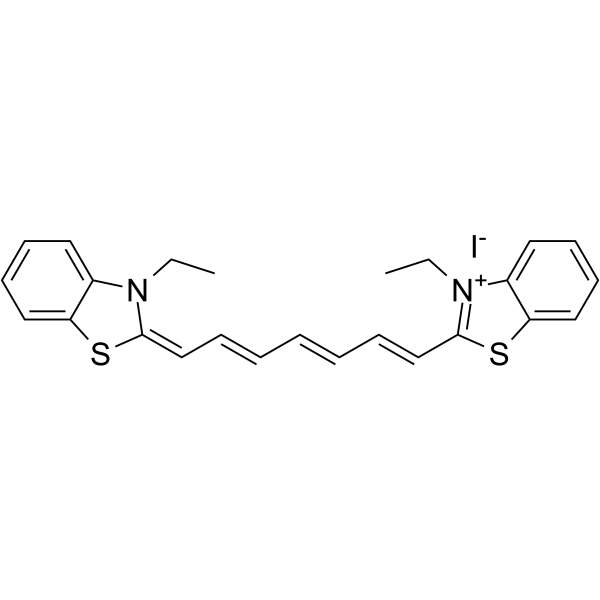3,3'-Diethylthiatricarbocyanine iodide

3,3'-Diethylthiatricarbocyanine iodide structure
|
Common Name | 3,3'-Diethylthiatricarbocyanine iodide | ||
|---|---|---|---|---|
| CAS Number | 3071-70-3 | Molecular Weight | 544.51400 | |
| Density | N/A | Boiling Point | N/A | |
| Molecular Formula | C25H25IN2S2 | Melting Point | 211ºC (dec.)(lit.) | |
| MSDS | Chinese USA | Flash Point | N/A | |
| Symbol |

GHS07 |
Signal Word | Warning | |
|
Structure-activity relationship of cyanine tau aggregation inhibitors.
J. Med. Chem. 52 , 3539-47, (2009) A structure-activity relationship for symmetrical cyanine inhibitors of human tau aggregation was elaborated using a filter trap assay. Antagonist activity depended on cyanine heterocycle, polymethine bridge length, and the nature of meso- and N-substituents.... |
|
|
Three-dimensional fluorescence lifetime tomography.
Med. Phys. 32(4) , 992-1000, (2005) Near-infrared fluorescence tomography using molecularly targeted lifetime-sensitive, fluorescent contrast agents have applications for early-stage cancer diagnostics. Yet, although the measurement of fluorescent lifetime imaging microscopy (FLIM) is extensive... |
|
|
Ionic dependence of membrane potential and glutamate receptor-linked responses in synaptoneurosomes as measured with a cyanine dye, DiS-C2-(5).
J. Neurochem. 48(2) , 552-9, (1987) Membrane potentials of particles present in a subcellular brain preparation, called synaptoneurosomes, have been monitored by measurement of changes in the absorbance of a cyanine dye, DiS-C2-5. The membrane potential of the particles seems to be dependent on... |
|
|
The application of a potential-sensitive cyanine dye to rat small intestinal brush border membrane vesicles.
Biochim. Biophys. Acta 732(1) , 324-6, (1983) The sensitivity of the fluorescent dye, 3,3'-diethylthiadicarbocyanine (DiS-C2(5], was too low for the detection of membrane potential changes in rat small intestinal membrane vesicles. Only after adding LaCl3 or after fractionation of the intestinal membrane... |
|
|
Longitudinal near-infrared imaging of myelination.
J. Neurosci. 31(7) , 2382-90, (2011) Myelination is one of the fundamental biological processes in the development of vertebrate nervous system. Disturbance of myelination is found to be associated with progression in many neurological diseases such as multiple sclerosis. Tremendous efforts have... |
|
|
Reduction in accumulation of [3H]triphenylmethylphosphonium cation in neuroblastoma cells caused by optical probes of membrane potential. Evidence for interactions between carbocyanine dyes and lipophilic anions.
Biochim. Biophys. Acta 762(4) , 585-92, (1983) The accumulation of [3H]triphenylmethylphosphonium cation in neuroblastoma N1E 115 cells in the presence of tetraphenylboron is reduced by 3,3'-diethylthiadicarbocyanine iodide and by 3,3'-dipropylthiadicarbocyanine iodide. This reduction in uptake of the lip... |
|
|
Fluorescence lifetime spectroscopy in multiply scattering media with dyes exhibiting multiexponential decay kinetics.
Biophys. J. 83(2) , 1165-76, (2002) To investigate fluorescence lifetime spectroscopy in tissue-like scattering, measurements of phase modulation as a function of modulation frequency were made using two fluorescent dyes exhibiting single exponential decay kinetics in a 2% intralipid solution. ... |
|
|
The effect of K+ and glutamate receptor agonists on the membrane potential of suspensions of primary cultures of rat astrocytes as measured with a cyanine dye, DiS-C2-(5).
Brain Res. 462(1) , 67-75, (1988) The cyanine dye DiS-C2-(5) was used to investigate the effect of K+ and glutamate receptor agonists on the membrane potential of whole populations of primary rat astrocytes in suspension. Increasing the external K+ concentration from 5 to 40 mM caused a depol... |
|
|
Laser detection of latent fingerprints: preparation of fluorescent dusting powders and the feasibility of a portable system.
J. Forensic Sci. 25(1) , 150-3, (1980) A simple procedure for the preparation of dusting powders with a variety of fluorescent colors is described. Such powders permit detection of latent prints by laser even when the surfaces holding the latent prints luminesce strongly. A possible portable laser... |